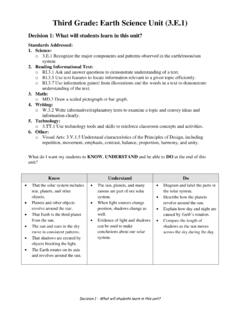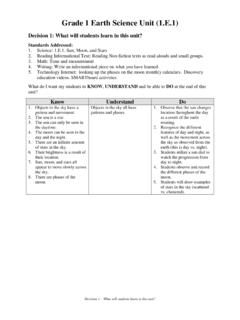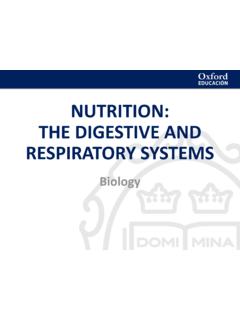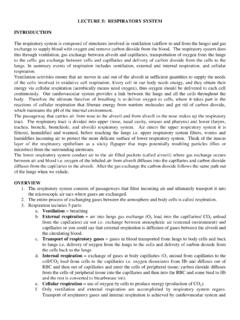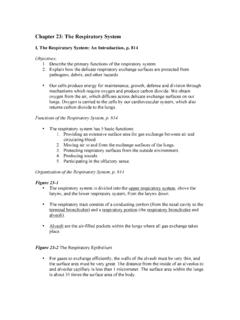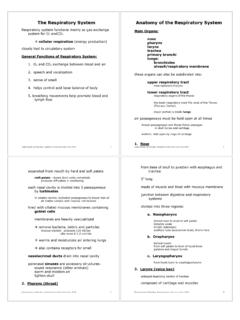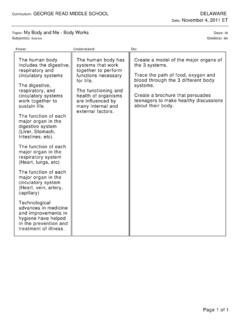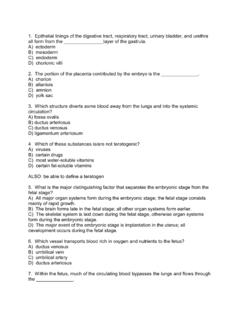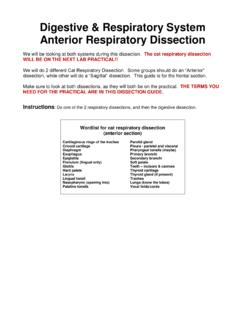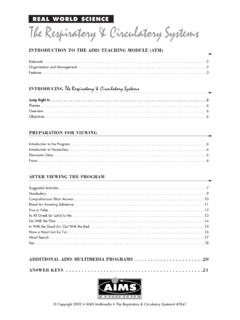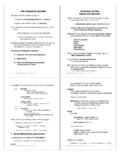Transcription of Grade 5 Life Science Unit (5.L.1) - Where Tomorrow Begins
1 Grade 5 life Science unit ( ) Decision 1 What will students learn in this unit ? Decision 1: What will students learn in this unit ? Standards Addressed: 1. Science : Understand how structures and systems of organisms (to include the human body) perform functions necessary for life . 2. Reading Informational Text: Explain the relationships or interactions between two or more individuals, events, ideas, or concepts in a historical, scientific, or technical text based on specific information in the text. 3. Math 4. Writing 5. Technology 6. Other What do I want my students to KNOW, UNDERSTAND and be able to DO at the end of this unit ?
2 Know Understand Do Essential Vocabulary: single cell multi cellular organisms Circulatory system heart, blood, vessels respiratory system nose, trachea, lungs Skeletal system bones Muscular system muscles digestive system mouth, esophagus, stomach, intestines Nervous system brain, spinal cord, nerves Why some organisms are capable of surviving as a single cell, while others require many cells that are specialized to survive. The major systems of the human body ( , digestive , respiratory , circulatory, muscular, skeletal, and cardiovascular) in terms of their functions necessary for life . Explain why some organisms are capable of surviving as a single cell while others require many cells that are specialized to survive.
3 Compare the major systems of the human body ( , digestive , respiratory , circulatory, muscular, skeletal, and cardiovascular) in terms of their functions necessary for life . Decision 2 Assessment Decision 2: Assessment Plan for how students will indicate learning and understanding of the concepts in the unit . How will you assess learning? Possibilities/options: Pre-assessment Short answer tests or quizzes Student logs, journals and informal writing Lab activities Formal writing assignments Informal or formal student Interviews, conferences, observations etc. Pre-assessment using ClassScape, Science notebooks/journals as a formative assessment, informal discussion, quizzes, culminating activity including rubric _____ _____ Describe the performance, product, or project that will be the culminating activity for the unit .
4 The student s assignment for the Culminating Activity includes: unit essential question or I Can statement for the culminating activity. A thorough description of the activity including steps or task analysis in completing the culminating activity. A copy(ies) of the rubric(s) you will use to assess the culminating activity or any other aspects of the unit . Task: Rubric: Decision 2 Assessment: Rubric Reminders Decision 2: Assessments Rubric Reminders: Scale Criteria 1 2 3 (Proficient) 4 Indicators What does each number or adjective in your scale mean? Decision 3 Student Learning Map Decision 3: Student Learning Map Key Learning Targets: I can analyze how simple and complex cells can sustain life .
5 I can compare the major systems of the human body. Concept: Single Cell and Multi-cellular Organisms Concept: Specialized Functions of Multi-cell Organisms Concept: Body Systems Lesson EQ(s): How do I distinguish between single-cell and multi-cellular organisms? Lesson EQ(s): How do I describe the specialized functions of multi-cellular organisms? Lesson EQ(s): What are the major body systems, their major parts, and their functions? Vocabulary: single cell multi cellular organisms complex organisms specialized algae bacteria amoeba Vocabulary: blood cells Vocabulary: circulatory system excretory system cardiac muscles liver oxygen kidneys carbon dioxide ureters arteries bladder capillaries urethra veins muscular system heart muscles blood nervous system respiratory system brain trachea spinal cord lungs nerves diaphragm neuron digestive system receptors esophagus skeletal system stomach bones intestines tendons bone marrow ligaments red blood cells white blood cells joints Concept: Interdependency Concept: Concept: Lesson EQ(s).
6 How do the body systems work together? Lesson EQ(s): Lesson EQ(s): Vocabulary: interdependent Vocabulary: Vocabulary: Decision 4 Launch Activities Decision 4: Launch Activities Hooks and Links Develops student interest and links prior knowledge. Provides the Student Learning Map and the key vocabulary to students. Guiding Questions: 1. How are you going to get students engaged? 2. How are you going to develop student interest and link their prior knowledge? 3. How are you going to start the Student Learning Map of the unit with students? 4. How are you going to preview key vocabulary with students? Inside Your Outside, by Tish Rabe (Part of the Cat in the Hat library) Vocabulary introduction: Guessing word meanings.
7 K-W-L chart CLIMB videos: NeoK12 Decision 5 Acquisition Lesson Planning Decision 5: Acquisition Lesson One Language Objective(s), Where appropriate: Explain the relationships or interactions between two or more individuals, events, ideas, or concepts in a historical, scientific, or technical text based on specific information in the text. Lesson Essential Question(s) or I Can Statement(s): How do I distinguish between single-cell and multi-cellular organisms? Activating Strategies: (Learners Mentally Active) What is life ? In small groups, have the students respond to the following questions: What is life ? What does it mean to be living?
8 What do all living things have in common? See what students know about what it means to be a living thing and what all living things have in common. Moving to Sides of the Room: Designate one side of the room as Agree and the other as Disagree. Have students read their beliefs to the class, and have the other students move to a side of the room to indicate their agreement. Student Learning Map: Hand out the student learning map. Preview the concepts and vocabulary. Acceleration/Previewing: (Key Vocabulary) single cell organisms complex organisms bacteria multi cellular specialized algae amoeba Teaching Strategies: (Explain and Model; Collaborative Pairs; Distributed Guided Practice; Distributed Summarizing; Graphic Organizers) Assessment Prompt #1: I can identify the parts of a cell.
9 Instructional Strategy #1: Teach about parts of a cell, and how those parts are enough to sustain life . Cello Activity: NeoK12 video clips: AP #2: I can identify single and multi-cellular organisms. IS #2: Provide and show examples of both single cell and multi-cellular organisms. Resources: Google Images, NeoK12 videos, foldable graphic organizer Reading Comprehension Passage: AP#3: I can distinguish between single cell and multi-cellular organisms. IS#3: Using a Venn diagram, have students identify similarities and differences between single and multi cell organisms. This can be done as a human Venn diagram, using tape on floor.
10 Give students a trait and have them decide Where to stand in the diagram. Distributed Guided Practice/Summarizing Prompts: (prompts designed to Initiate Periodic Practice or Summarizing) Summarizing Strategies: Learners Summarize and Answer Essential Questions On a Post-it note, list three single-cell organisms, and three multi-cellular organisms. Lesson Resources Cello Activity - NeoK12 video clips - Decision 5 Acquisition Lesson Planning Decision 5: Acquisition Lesson Two Language Objective(s), Where appropriate: Lesson Essential Question(s) or I Can Statement(s): How do I describe the specialized functions of multi-cellular organisms?

